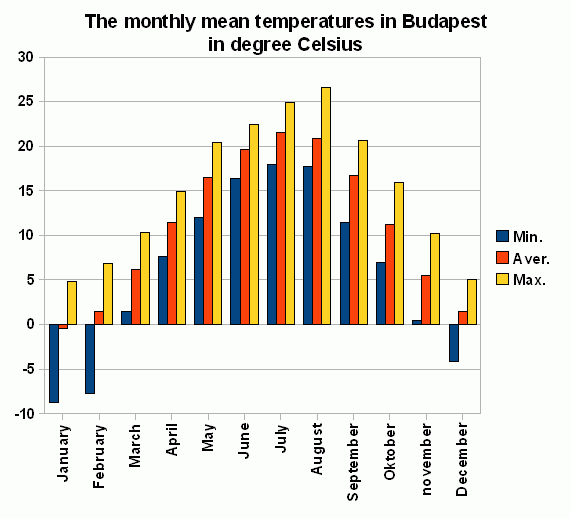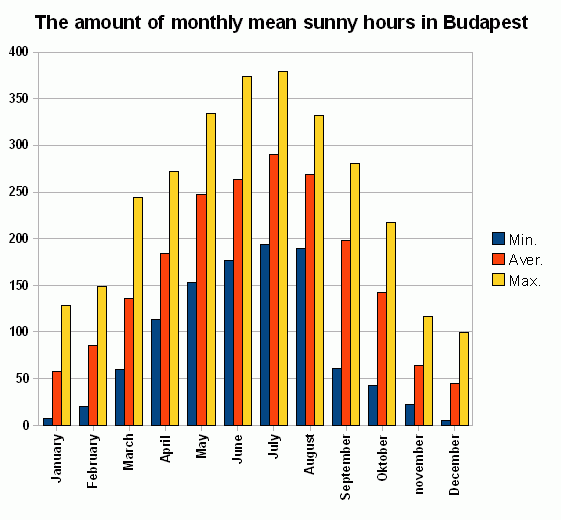Hungary has a mainly continental climate with big yearly temperature change, it has four different seasons and generally a little bit lower average temperature, than the global. The Hungarian summer is long and generally dry, the average temperature of three months (June, July and August) exceeds the 18 degrees Celsius and many times the highest temperature reach the 35 degrees Celsius. The hotter month is the July with 22 degrees Celsius average temperature. The temperature of the winter is changeable, cold and warmer times follow each other, but there is only one month (it is January) with lower average temperature, than 0 degree Celsius. Winters are usually dry, we have only rarely bigger snow, mainly in the mountains.
The yearly amount of the rainfall is changeable (600-1000 mm), it depends on the regions - among the mountains more, on the plains less, but generally the spring and the autumn are the two more wet seasons.
The amount of the sunny hours is between 1700 and 2100 - among the mountains less, on the Big Hungarian Plain is the most. Hungary do not have any seaside but it lies close to them, so our climate is influenced by three big factors: first the continental climate, but in second line the wet and mild oceanic climate and the mediterrain climate have a big effect to the Hungarian weather.

The mounthly mean temperatures in Budapest

The mounthly mean rainfall in Budapest

The amount of mounthly sunny hours
But what does it means in the reality? I try to explain it with simple words.
Generally the second half of April, May and early June have a lot of rain. That time the big Atlantic cyclones run through Hungary and they bring always rainfall.
Later the cyclones don't touch Hungary because generally develops a high pressure area above the Carpathian Basin and it force the weaker Atlantic cyclones onto a more northern route through the German and Polish plains. This is the time of the hot and dry Hungarian summer! Only the explosive local thunder-showers can decrease the hot. These high pressure areas live only 5-10 days, because the stonger Atlantic or Mediterranean cyclones can break through them and bring 1-3 wet and cool days. The end of this long period is usually in the second half of August. The different Mediterranean and Atlantic cyclones follow each other in the whole September, we have only short pauses among them. But generally they are “dry” and don't bring a lot of rain.
Later we have a shorter or longer sunny period in Oktober - this is the time of the Hungarian “Indian Summer” - but November is a generally wet month and the December bring the cold.
This was the description of a usual year. But the global warming has changed a lot of things in the climate of Hungary. What does it means? On the one hand the sudden changes are bigger: the cyclones are more stormy and powerful after the dry and very hot periods, on the other hand the difference among the same seasons are bigger. For example the summer of 2006 was very wet, but in 2007 we didn't see any rain! 2008 and 2009 were two average years, but 2010 was the rainiest year in the history of the Hungarian meteorogy!
If you plan a two weeks long hike in Hungary in any times, it is almost sure, that you will get a longer-shorter rainy period!
And finally I would like to show a few diagrams about the weather of Hungary. I have collected the data and made these graphs from the data archivum of the last 100 years' meteorology in Budapest. These data are on the website of the Institute of Meteorology . The capital is in good geographical position to explain the Hungarian weather, because it lies on the border of the northern mountains and the plain.
You can see three diagrams on the right side. Let's speak first about the temperature! The blue columns show the monthly average temperature of the coldest months in the past 100 years in Budapest, the yellow ones show the hottest months and the red ones the 100 years monthly mean temperature in Budapest.
The second graph shows that July, August, September and Oktober have the smallest rainfall between the rainy weather of the spring and autumn. But you have to remember, that these months are not totally dry! There is a big chance to get a rainy period even in the summer!
And the third one is a very interesting diagram. It shows the amount of the sunny hours in an average month (red column), in the sunniest month of the century (yellow column) and in the cloudiest month (blue column). The graph shows, that the most sunny months are the June, July, August and September in average, but the autumnal months (September and Oktober) can be either very nice, or (rarely) very bad!
As you can see, the weather of Hungary changes often, so I would like to recommend a few good meteorological websites in the LINKS chapter, where you can follow well the unpredictable Hungarian weather!
| The name of the hosting provider: | Port Kft. |
| The postal address of the hosting provider: | 9200 Mosonmagyaróvár, Szent István király út 60. |
| E-mail address of the hosting provider: | info@webtar.hu |
| The name of the author and editor of the website: | Horváth Béla |
| E-mail address of the author and editor: | horvabe1959@gmail.com |
| The information on this website is true and complete to the best of the author's knowledge. All recommendations are made without guarantee on the part of the author. The author disclaims any liability in connection with the use of this information. | |
 Creative Commons license: Attribution-NonCommercial-NoDerivatives 4.0 International Creative Commons license: Attribution-NonCommercial-NoDerivatives 4.0 International | |
| Please read the Cookie Policy of this website! It contains important information! | |
